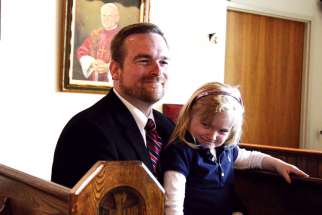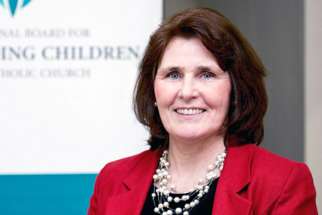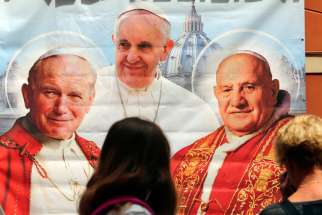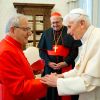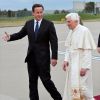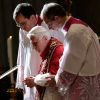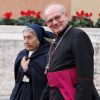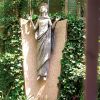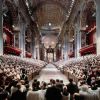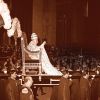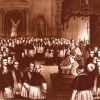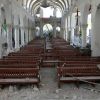School chaplain gives new life to church goods
TORONTO - When Mark Siolek read an article about a bar owner purchasing confessionals from the Archdiocese of Buffalo to be used in bathrooms, his stomach turned.
DUBLIN - The independent watchdog that monitors child safeguarding procedures in the Irish Church pledged to follow the example of Pope Francis and "disturb the peace."
VATICAN CITY - Just days before Pope Francis was set to canonize two of his predecessors, he expressed his hopes the two soon-to-be saints would continue to inspire the whole church in its mission.
Chaldean Catholic bishops elect Kirkuk archbishop as new patriarch
VATICAN CITY - The new head of the Chaldean Catholic Church, Patriarch Louis Sako of Baghdad, told his fellow Chaldean bishops and Vatican officials, "We want to follow the example of our martyrs who gave their lives for Christ."
Churches throw support behind Chief Spence
As Chief Theresa Spence passed three weeks living on nothing but water, fish broth and herbal tea, churches and Christian organizations were lining up behind her request for a meeting with Prime MInister Stephen Harper, Governor General David Johnston and aboriginal leaders from across the country.
Britain to propose allowing same-sex weddings in churches
MANCHESTER, ENGLAND - The British government has expanded its push to legalize same-sex marriage to include allowing same-sex couples to marry in churches.
Church coalition demands action on climate change
As Environment Minister Peter Kent prepared to head to Doha, Qatar, to represent Canada at United Nations-sponsored climate talks, Canada’s Catholic bishops and the Canadian Council of Churches prodded him to do more to prevent a warmer, less livable planet.
Celebrating Church's universality, Pope creates new cardinals
VATICAN CITY (CNS) -- Recalling that Christ's mission transcends "all ethnic, national and religious particularities," Pope Benedict XVI created six new cardinals from four different continents, representing the Latin rite of the Catholic Church as well as two Eastern Catholic Churches.
Truly universal Church
When Pius XII became Pope in 1939 the college of cardinals had token representation from Latin and North America, one cardinal from the Middle East and none from the rest of Asia or from Africa. It was 89 per cent European.
By the time Pius died in 1958, the college had welcomed cardinals from Africa, India and China, Latin American representation had tripled and European membership was just 64 per cent of the total. The internationalization of the Vatican had begun.
But the journey has been slow since then even though European Catholics as a percentage of the worldwide Church have been in steady decline, if not outright free fall. So it was welcomed news last month when Pope Benedict announced a “little-consistory” for Nov. 24 to create six new cardinals who come from six non-European countries.
In doing so, history of sorts is being made. This is the first consistory in a thousand years of cardinal making in which Europe and North America are outnumbered by new cardinals from the developing world. In addition to one American, red hats are going to bishops from Lebanon, India, Nigeria, Colombia and the Philippines. Together they reflect the changing face of a Church in which two-thirds (and growing) of its members live in Africa, Asia and Latin America.
The Church continues to evolve. Announcing the consistory last month, Pope Benedict called it recognition that “the Church belongs to all peoples, speaks all languages.” In a reference to Europe, he said the consistory confirms “it is not the Church of one continent but a universal Church.”
Last February, the Pope added 18 new elector cardinals at a consistory that raised eyebrows for being European-heavy, naming just three new cardinals from the developing world. Africa, despite having the world’s fastest growing Catholic population, was completely shut out. Adding five non-Westerners now doesn’t even things out but it puts a welcomed dent in the imbalance and foreshadows the future.
The newest cardinals are relatively young. Two are in their 50s, the oldest is 73 and the average age is 63. In addition to helping select future popes, they will sit on various Vatican committees and exert influence for many years to come.
Also, these additions bring the college to its full complement of 120 electors for a new pope, and lowers European votes to 51 per cent of the total. That’s not much different from when Benedict became Pope in 2005. What continues to change, however, is the demography of the world’s one billion Catholics. The Church is projected to be 75 per cent non-Western within the lifetime of many of the new cardinals.
How that impacts the Church will be watched closely, particularly so for the papacy, an institution that has been mostly Italian and always European for the last 12 centuries.
Church needs witness of women proud to be Catholic, archbishop says
VATICAN CITY (CNS) -- New evangelization will never be possible without women who are proud and happy to belong to the Catholic Church, the president of the Belgian bishops' conference told the Synod of Bishops.
"Two-thirds of active members of the Church are women," and the primary evangelizers are usually women, "however many women feel discriminated against by the Church," Archbishop Andre-Joseph Leonard of Mechelen-Brussels told the synod Oct. 9.
"It's high time" the Church better explain why only men may be ordained, he said.
It is not because women are looked upon as being less worthy or able to minister to others, "it's absolutely the contrary," the archbishop said.
The priesthood is open only to men "because the male figure of the priest is a representative of Christ, the groom, who came to wed humanity" through his spouse, the Church, he said.
A male priesthood "is only out of respect for this profound symbol of marriage," Archbishop Leonard said. "Let us remember and remind the Church of her profound feminine nature as the bride of Christ and our mother."
The archbishop spoke forcefully and with emotion, said Basilian Father Thomas Rosica, who briefed reporters about what occurred in the synod hall. The speech was a bit of a "shocker," said one synod participant, because the archbishop is considered to be very conservative.
Archbishop Leonard asked everyone to give thanks for "the quality and the specificity of the massive contribution of women to evangelization."
"Without joyous women who are recognized for all of their qualities" and who are proud of belonging to the Church, "there will be no new evangelization," he told synod participants.
He called on church leaders to "never hesitate to entrust more important roles to women in the life of the Church. We must find new and strong ways to do this," he said.
Synod participants spent the morning session Oct. 10 in small groups divided by language.
In one of the four English-language groups, Cardinal Timothy M. Dolan of New York made great efforts to get the three women and four laymen in the group to speak and participate as much as the bishops, according to Father Rosica.
Together with Australian Cardinal George Pell of Sydney, Cardinal Dolan "created a mood to speak because there was a little bit of timidity" within the group of 30 English-speakers, said Father Rosica, who is part of that working group.
Cardinal Dolan said it was his first experience at a world Synod of Bishops, and that he was not there just to sit and listen to bishops, but to also tap into the rich experience and expertise of the religious women and laypeople attending as experts or observers who normally do not get a chance to address the larger assembly.
Father Rosica said the initiative was "very well-received" and that one nun told him she was pleased they weren't there "just to sit in the back and listen."
New York church welcomes the UN
NEW YORK - It’s known as the United Nations church.
About halfway along 47th Street, just west of the UN’s iconic tower on First Avenue in Manhattan — and in an area known as Dag Hammarskjold Plaza — is Holy Family Church, a name that also reflects its long time roots in the city’s east side neighbourhood, where it also serves 500 families in the community.
The present Holy Family building, a stunningly beautiful modern structure, was dedicated by Cardinal Francis Spellman in 1965, just before Pope Paul VI’s visit to the UN in October of that year. A cornerstone commemorates an ecumenical meeting the pontiff held at the church. The parish actually dates to the 1920s when it was established as the church for the local Turtle Bay Italian neighbourhood.
The church plays a significant role in the UN community by housing the residence and office of the Permanent Observer of the Holy See to the United Nations, as well as offices of national and international UN-related Catholic organizations. The church’s dedication was attended by then UN Secretary General U Thant. Holy Family continues to be the site of many UN religious observances.
“In fact just this past Monday we had a prayer service for the opening of the General Assembly,” Fr. Robert Robbins, the church’s pastor of 23 years, said in a late September interview. Ambassadors and UN personnel attended.
Robbins, a native of the Bronx who is leaving Holy Family for several new roles with the New York archdiocese, including director of community outreach, says the international flavour of the parish creates a unique community.
“It’s always interesting because what we have is a New York City parish which is also attempting to reach out to Catholic members of the UN with different cultural backgrounds, so each time something presents itself — for instance a memorial service or something like that — you’re going to get the mission in from Peru or some other country,” he said.
“It’s just very interesting trying to deal with the language differences, the cultural differences, also the religious expression, because South American countries especially have devotions that wouldn’t be known to us in North America.”
Parishioner Margie Skeels, a former parish council president who works with the UN Development Program, said being a member of the church “raises the level of my faith. Personally I have a chance to live my faith through the UN.”
The building is almost awe-inspiring in its architecture and art work — with sculptures, altars, stained glass and a unique presentation of the Stations of the Cross — created by various international artists, including a Canadian.
The original church was built on a stable because the area between First and Second Avenues once abounded in slaughterhouses. Some of that building is contained in the present structure.
The new church’s architect, George J. Sole, created a church symbolic of a stone monument and which partly harmonizes with the UN building itself. The exterior’s gray granite walls consist of panels with a cruciform pattern surrounded by four squares, representing a community gathered around Christ. The interior is spare, but that complements its breathtaking artistic details.
The altar is made from black granite quarried near the Canadian Arctic, behind which is a towering aluminum sculpture of the Risen Christ with a large testa or crown of lights. It, along with the statues at the two side altars, and the statue of the Virgin Mary in an outside garden next to the church, were made by the Italian studio of Nagni. The side altars represent themes of sacrifice, universality and peace.
The west wall incorporates the related grouping of three large stained glass windows and three ceramic sculptures, referencing the Holy Family’s flight into Egypt with the dispossession of contemporary refugees.
The Stations of the Cross, on the east wall, are one continuous set of sculpted images. In the 11th station, the sculptor has pressed into clay the tools used in the crucifixion. In the 12th, there is a reference to the Manhattan skyline as a backdrop to Christ hanging on the cross.
The stations, windows and ceramics are all from the studio of Catalan-born artist Jordi Bonet, who emigrated to Canada and worked from a studio in Montreal until his death in 1979. His sculptures can be seen as far afield as JFK airport in New York and the Pie-IX subway station in Montreal.
(Stang is a freelance writer in Windsor, Ont.)
The Church’s past weaved into the future
The Second Vatican Council might be easier to understand if it had been called Back To The Future.
The two central ideas of the council appear to be headed in opposite directions. The first goes by a French title, resourcement, the second by an Italian one, aggiornamento.
Resourcement was a movement back in time. For half a century before the 1962-1965 council, theologians and many ordinary Catholics had been calling the Church back to its roots in Scripture, the early Church and even the Judaism of Jesus and His apostles. The Latin war cry on behalf of resourcement at the council was “Ad fontes!” (“To the sources!”), and one of its greatest advocates was Fr. Joseph Ratzinger. He would go on to interpret the council as a theologian, bishop, cardinal, prefect of the Congregation for the Doctrine of the Faith and now as Pope Benedict XVI.
Aggiornamento looked forward. It was how Pope John XXIII explained the basic impulse of the council. He wanted to open up the doors and windows of the Church and welcome in the world, to greet the modern age and all its cultural and technological revolutions with something more than suspicion, fear and rejection. The word means “up to the moment” in the sense of renewal.
Fifty years ago, the job of 2,860 bishops, with help from almost every significant theologian then living, was to weave the past and the future — resourcement and aggiornamento — into a seamless garment. As hard as the Church has worked to pull together those two impulses, other Catholics, conservative and liberal, have tried to pull them apart — or make one end of the spectrum more important than the other.
Liberal theologian Gregory Baum, who worked for Cardinal Augustin Bea at the Council, isn’t surprised that people want to downplay aggiornamento and all that it brought.
“There are people for whom religion means security. The world changes, everything changes, nothing is reliable,” Baum told The Catholic Register. “But the one thing that’s reliable and is unchanging is the religion they have inherited — not God, but the religion we have inherited.”
Change even small parts of their religion and you threaten people’s security, Baum said.
“It is a frightening thing,” he said.
Since the 1970s Fr. Alphonse de Valk, a conservative writer and founder of Catholic Insight magazine, has objected to the idea that the council could change the Catholic Church.
“I always supported the council,” de Valk said. “What I have attacked of course is the spirit of the council in which people said all sorts of silly things that were never discussed in the council... The ones I have opposed for these 50 years were the ones who said that the Vatican Council was a whole new beginning for the Catholic Church, and that this was something radically new, and we could forget everything we had ever been taught.”
Controversy over the council often obscures its historical context. It convened less than 20 years after the Second World War, in the shadow of the Cuban Missile Crisis, in the middle of the Cold War. At the same time, the council needs to be understood in the light of contemporary challenges to the Church, said Saint Paul University theologian and ecumenist Cathy Clifford.
“It’s probably more challenging today, even 50 years after Vatican II, because the Church is twice the size it was 50 years ago and now two-thirds of Catholics are in the southern hemisphere and non- European cultures,” she said.
From an African perspective, the Second Vatican Council was in a slightly different context. It came at the end of the colonial era, when more than 50 new nations were being born on that one continent.
“It has now become global. It’s the Church of the whole world,” Cardinal Peter Turkson told The Catholic Register. “We had a true representation of the world Church.”
For two generations after the council the African Church grew. Missionaries were replaced by local, African clergy. The continent went from 15,000 priests in 1962 to 40,000 in 2012. New dioceses with new bishops came into existence. The Novus Ordo Mass really is a new world order in Africa, with women and children dancing up the aisle to present the gifts and music that soars and thrills in natural three-part harmony pushed ahead by drums.
At the council the hierarchy of the Western Church — from the pope down through to deacons — invited the interaction of lay people. Just 24 years old in 1962, while studying theology at Toronto’s University of St. Michael’s College, Janet Somerville took up the invitation with joy and gusto. She witnessed the transformation from the days when people prayed rosaries while the Sunday readings poured off the ambo in Latin. Not just her mind, but her heart was opened by a sophisticated, scientific reading of the Bible rooted in history. At the same time, Catholics and Protestants were suddenly talking together about their faith.
“To me it felt as if the Catholic Church was renewing and reaffirming its rootedness in Scripture just in time to welcome much
more warmly the gifts of the Spirit that were flourishing in the Churches of the Protestant Reformation,” said Somerville. “I just rejoiced at that.”
She also rejoiced that a pope could cry “No More War” in an address to the entire world, as Pope John XXIII did in his encyclical Pacem in Terris. When the Vatican Council defined the Church in response to “The joy and hope, the grief and anguish of men of our time” in Gaudium et Spes, she knew it was just right.
Fifty years later it’s still just right, but bears reading again, she said. All that joy and optimism made it harder to see the full picture.
After a lifetime of work in religious journalism, a career as a CBC producer and as the first Catholic general secretary to the Canadian Council of Churches, Somerville has come to appreciate a little the conservative caution about Vatican II.
“Do I think we need more Catholic identity? Yes, I do,” she said. “But not because the Second Vatican Council wasn’t saying the things we need to know and the things we need to hear. It was. And not because we need to re-inculcate such a fear of the world and such a suspicion of the world that (the world’s) noble side and its great aspirations are as taboo in our homes as sexy advertising and consumerism and greed and living for the moment.”
There’s no shortage of people who wanted more out of the Second Vatican Council — more collegiality, more openness, more change, less centralization.
“By and large, certainly (the council) has been dealt some very serious blows,” said Jesuit Church historian John O’Malley.
But turning the counci l into a cultural battleground doesn’t advance the cause, said Clifford.
“I don’t know if disappointment is the kind of response that is helpful,” she said. “It is important to recognize that we haven’t fully received what the council taught. We haven’t fully implemented many of the structures that were provided for, even in the revision of the Code of Canon Law that followed the council. In some ways, we’ve received the council in a minimalist way.”
Hope is the response that Pope Benedict XVI has tried to foster.
“Many people have given up the fight. Many people have just lost interest, which is even worse,” said Somerville. “Pope Benedict XVI has a very interesting balance in the way he never rejects the council but does not put any short timelines on any of the victories we were confidently expecting.”
Hope was how it all started.
In 1959 Pope John XXIII first discussed with a few of his cardinals just what he had in mind. He told them: “I am thinking of the care of the souls of the faithful in these modern times... I am saddened when people forget the place of God in their lives and pursue earthly goods as though they were an end in themselves. I think, in fact, that this blind pursuit of the things of this world emerges from the power of darkness, not from the light of the Gospels, and it is enabled by modern technology. All of this weakens the energy of the spirit and generally leads to divisions, spiritual decline and moral failure. As a priest, and now as shepherd of the Church, I am troubled and aroused by this tendency in modern life and this makes me determined to recall certain ancient practices of the Church in order to stem the tide of this decline. Throughout the history of the Church, such renewal has always yielded wonderful results.”
The good pope was not speaking as a theologian, but as a pastor. A year into his own papacy, Pope Benedict gave a name to Pope John’s hopeful, pastoral impulse. He called it the “hermeneutic of reform.”
“With the Second Vatican Council the time came when broad new thinking was required. It’s content was certainly only roughly traced in the conciliar texts, but this determined its essential direction so that the dialogue between reason and faith, particularly important today, found its bearings on the basis of the Second Vatican Council,” he said.
Hermeneutic is a technical term in philosophy meaning a method of interpretation. Benedict famously contrasted interpretations of the Council based on reform with interpretations based on “discontinuity and rupture.” It is wrong to imagine the Church somehow started again in 1962, or that the Church before the Council was a different Church. There is only one mystical body of Christ, and it is the same through all time.
A Church reborn: The 50th Anniversary of Vatican II
On Jan. 25, 1959, a new pope shocked the world. Pope John XXIII, speaking to a small group of Roman cardinals following a liturgy to conclude the Week of Prayer for Christian Unity, announced that he had decided to convene an ecumenical council.
Pope John, elected less than three months earlier, had previously told only one person of his plan and had consulted with no one else. He had little ideaof why he wanted a council. He did however refer to “the strengthening of religious unity and the kindling of a more intense Christian fervour.”
The Church, he said, was on the threshold of a new era in history when it would be necessary “to define clearly and distinguish between what is sacredprinciple and eternal Gospel and what belongs rather to the changing times.”
With those comments, Pope John struck a few notes that would eventually help to characterize the much-maligned “spirit of Vatican II,” but not until after concerted resistance from the Vatican’s own Curia had been overcome.
Essentially, the Pope’s decision to call the council was an inspiration or an intuition that such a great gathering was needed. When the council finally opened on Oct. 11, 1962, he said the idea for the council had come “like a flash of heavenly light” . . . “a sudden emergence in our heart and on our lips of the simple words ‘ecumenical council.’ ”
Few, if any, ranking churchmen in early 1959 believed that a council was necessary. In the past, councils had been called to respond to crises in the Church, especially over doctrine. But now there was no doctrinal crisis nor was there a pastoral crisis. The Church was apparently in wonderful shape, certain of its teaching and, throughout the Western world, its worship halls were full.
Moreover, after the First Vatican Council in 1870 had declared the doctrine of the infallibility of the Pope, many believed that there would never again be a need for a worldwide council. Gotta problem? The Pope will solve it with a clear, unequivocal declaration.
But Pope John did call a council. And what a council it was! Fifty years later, its reverberations are still being felt throughout the Church. Indeed, the debate over what the council said and meant is ongoing, even increasing in fervour. The process of implementing the council is still incomplete.
Today, the 16 documents of the Second Vatican Council form a foundation for the life of the Church. But if in 1965 those documents seemed almost revolutionary, today they seem less so.
Angelo Giuseppi Roncalli became a pope like no other in the 20th century. He rose to become Pope John XXIII basically under the radar and was formed by a unique set of experiences that helped him understand that the action of the Holy Spirit is not confined to the Catholic Church.
He was not a radical or even an innovator. Judged by today’s standards, his public comments and private correspondence can only be described as quite conservative. While his papacy had a markedly different style than that of Pope Pius XII, his reserved predecessor, Pope John seems to have taken only one off-the-wall action in his life — to convoke Vatican II.
In October 1958, Pope Pius XII died after years of illness. Roncalli was quickly seen as one of the leading candidates to be his successor. Why? First, at age 76, he would be a transitional pope after Pius’ long 19-year pontificate. Second, he was not part of the Vatican power structure that had grown too strong in Pius’ declining years. Third, he was seen as a bridge-builder, someone who would be accessible to the cardinals and a pastor to the people.
Further, although he was 76, Roncalli was actually one of the younger cardinals. Pius had held only two consistories to appoint new cardinals during his long pontificate. With only 51 cardinals entering the conclave and many of them quite elderly, the pool of papal candidates was small.
Still, it took 11 ballots before he was finally elected. Why the hesitation? Some, it appears, felt Roncalli lacked the intellectual heft to lead the Church, even for a short period. Nevertheless, he was elected and chose the name John. Less than three months later, this “transitional pope,” without consulting anyone other than the Holy Spirit, started the wheels in motion for the Second Vatican Council.
Recently, a group of scholars published a book, Vatican II: Renewal Within Tradition. The book examines the 16 documents in some detail, carefully pointing out that the council did not erase what came before it. The teachings of Vatican II are totally in continuity with what the Church had taught previously. There is evolution and development of doctrine, but no radical break with the past.
This may be true, but those old enough to remember the Church before Vatican II, and who recall the earthquake that it represented in the life of the Church, cannot be satisfied with such a placid account.
Franciscan Father Don MacDonald, who teaches a course on Vatican II at Newman Theological College in Edmonton, believes Vatican II has been misunderstood. Some believe the purpose of the council was to make being a Catholic easier and to help Catholicism adapt to the modern world. That’s wrong on both accounts.
The Church has never tried to adapt itself to the world, MacDonald said, and the council made the faith more demanding, “in the best sense of the word.” The Church before Vatican II was not the good ol’ days, he said. A lot needed to change.
In the seminary, MacDonald recalls being taught that how a priest celebrates Mass was more important than what was being celebrated. The emphasis placed on how the priest held his hands during Mass “was almost like a phys-ed exercise.”
Still, there was a lot of “heroic Catholicism” and a strong emphasis on social action in the Church prior to the council, he said. “You have to have respect for that pre-Vatican II faith.”
There is more to Vatican II than what is found by studying its documents. If there was doctrinal continuity in the council’s teachings, there was also an enormous upheaval in the life of the Church. Some of that upheaval may well be due to misinterpretations and over-enthusiasms. Part of it is no doubt the result of a greater embracing of Western culture which, in the 1960s, underwent massive convulsions.
But above and beyond all that, a sea change took place in the Church that was necessary and productive.
The liturgy underwent a process of revitalization that is still continuing. Greater contact with non-Catholic Christians and people of other faiths was encouraged. A static, deadening approach to theology was jettisoned in favour of one that allowed room for inquiry and evolution.
The Church endorsed religious liberty and rejected the notion that error has no rights. The full equality of the People of God in Baptism was recognized and holiness was seen as God’s call to everyone, not just a spiritual elite. There was, in short, greater openness and less fear of “enemies.”
For many, that openness was disorienting. When the central religious rituals of one’s life are altered, it is likely to deeply unsettle one’s relationship with the Transcendent. That fact and the effects of other changes were not sufficiently appreciated in the mid- 1960s. These are likely not the only causes of a mass exodus of priests and religious from their callings and laity from regular Church attendance. But an honest evaluation of the changes should see them as contributing factors.
Still, a reform of the liturgy was necessary and perhaps overdue. As well, it must be said that one can be faithful to the letter of the Church’s teachings and still acknowledge a legitimate “spirit of Vatican II” that is in harmony with those teachings. It is impossible to tell the full story of Vatican II without acknowledging its history and without trying to come to grips with that legitimate spirit.
Communications and transportation networks were far less developed 50 years ago. As well, the Church’s theology of collegiality among bishops was practically non-existent and there were few joint episcopal efforts. When the bishops arived at Vatican II in 1962, many were meeting prelates from around the world for the first time.
Canada’s bishops and Catholic universities were among those who responded to the Vatican’s call in 1959 for input about topics to be considered at the Second Vatican Council. Canada was a far different country then and the same could be said for the Canadian Church. If parishes and dioceses today seem to be somewhat isolated cocoons, it’s nothing compared with the situation prior to Vatican II.
Given all that, it is perhaps not surprising that suggestions from Canada’s bishops lacked vision. In the mid-1990s, Michael Fahey of the University of St. Michael’s College in Toronto examined the input of the Canadian bishops prior to the council. For the most part, it reflected “notably weak” theology and the “generally poor state of collegiality in Canada,” Fahey wrote in L’Eglise canadienne et Vatican II (edited by Gilles Routhier). But what is remarkable, he noted, is the extent to which their vision was transformed by the time Vatican II ended in 1965.
What did the Pope expect out of Vatican II? Raised in the tiny village of Sotto il Monte by peasant farmers who kept cows in their house, Pope John had the audacity to convoke an ecumenical council of the entire Roman Catholic Church. Moreover, he didn’t even have a plan for this whimsical council. But he said it would provide for “the enlightenment, edification and joy of the entire Christian people” and that the faithful of other Christian churches would be invited too.
The Pope said the idea to call the council came to him “like a flash of heavenly light.” Other Church leaders felt quite in the dark.
Pope John was known for his sense of humour and his positive outlook on life. Perhaps it was these factors that led him to say, two years after his Jan. 25, 1959 announcement that the Church would hold a worldwide council, that the announcement was greeted by the cardinals present with “a devout and impressive silence.”
No applause greeted the papal announcement in the Basilica of St. Paul. Church historian Giuseppe Alberigo says the reaction of the 17 cardinals present was “characterized by bewilderment and worry.”
No one in the know could see any reason for a council. For the Rome-based cardinals, who had run their offices at the Vatican with little oversight from the ailing Pope Pius XII for several years, a general council could only mean trouble. The Vatican would be flooded with bishops from around the world, bishops unfamiliar with Roman ways, the vast majority of whom the cardinals themselves did not know.
Even Cardinal Giacomo Lecaro of Bologna, who would later become one of the progressive leaders at Vatican II, groused, “How dare he summon a council after 100 years and only three months after his election? Pope John has been rash and impulsive. His inexperience and lack of culture brought him to this pass, to this paradox.”
Cardinal Giovanni Battista Montini, later Pope Paul VI, was initially cool to the call for a council. But perhaps inspired by the excitement in his Milan archdiocese, he wrote a pastoral letter stating, “A flame of enthusiasm swept over the whole Church. He understood immediately, perhaps by inspiration, that by calling a council he would release unparalleled vital forces in the Church.”
If many cardinals were dubious about the council, the rest of the world was not. Almost spontaneously, people around the world — Catholic and non-Catholic — saw the council as a great sign of hope and renewal in the Church. The expectation created overnight was tremendous.
(Western Catholic Reporter)
Councils date back to early days
The model for all ecumenical councils is the Council of Jerusalem, recalled in the Acts of the Apostles, chapter 15. However, it is not generally listed as one of the 20 ecumenical councils of Church history. Ecumenical (from the Greek word oikoumene) means worldwide, and the first one was called by the Emperor of the known world, Constantine I.
1. First Council of Nicea in 325 defined the heresy of Arianism.
2. First Council of Constantinople in 381 again repudiated Arianism.
3. Council of Ephesus in 431 declared Mary as "God carrier" or Theotokos.
4. Council of Chalcedon in 451 made more explicit that Jesus' divine and human natures were united in a single being.
5. Second Council of Constantinople in 553 condemned Origen of Alexandria, the first great Scripture scholar of Christianity, for some odd ideas he had about the transmigration of souls.
6. Third Council of Constantinople in 680-681 dealt with more threats to unity of Christ, specifically a theory that Jesus had two wills — one divine and one human — but one nature. Monothelitism was condemned as heresy.
7. Second Council of Nicea in 787 tried to stop people from going around smashing icons. Veneration of icons was defined as good and iconoclasm was condemned.
8. Fourth Council of Constantinople in 869-870 restored St. Ignatius to his throne as Patriarch of Constantinople.
9. First Lateran Council in 1123 excommunicated the Holy Roman Emporer Henry V and declared it heresy for kings, princes and even the Holy Roman Emporer to appoint bishops. This was known as the investure controversy and it went on for centuries. The council also tried to impose celibacy on secular priests.
10. Second Lateran Council in 1139 was another attempt to get kings out of the business of the Church, and also tried to reform the clergy, including another condemnation of marriage among priests.
11. Third Lateran Council in 1179 condemned the sale of sacraments and positions in the hierarchy (simony) and declared only cardinals could elect the pope.
12. Fourth Lateran Council in 1215 defined transubstantiation, a term that remained controversial at the Second Vatican Council.
13. First Council of Lyon in 1245 excommunicated and deposed Holy Roman Emperor Frederick II who had put Rome under siege. Pope Innocent IV also used the Council to strike an alliance with King Louis IX of France and launch the Seventh Crusade under the French king's command.
14. Second Council of Lyon in 1274 under Blessed Pope Gregory X tried to repair the Great Schism of 1054. However, Greek Orthodox bishops were condemned for attending the Council when they returned home.
15. Council of Vienna in 1311 to 1312 marked the end of the crusades. The Knights Templar lost their Church support and Franciscan Ramon Llull (Raymond Lully) convinced the Council fathers the only way to retake the Holy Land was to learn the languages — specifically Hebrew, Arabic and Greek.
16. Council of Constance in 1414 to 1418 had to solve the problem of three popes: Anti-pope John XXIII, Avignon Pope Benedict XIII and Pope Gregory XII had all been elected by some bishops in a situation known as the Western Schism of 1378 to 1417. The Council of Constance resolved the schism by declaring an ecumenical council is a higher authority even than the pope who convokes it and then installing Pope Martin V.
17. Council of Florence opened in 1431 in Basel with no bishops, moved to Ferrara, Florence and finally Lousanne. There were wars in Bohemia, a rising threat in the Ottoman Empire and plague. The council tried to assert the idea of conciliarity, that councils should be part of the normal governance of the Church, and it achieved a short-lived reconciliation with some Greek Orthodox bishops and the Armenian Church.
18. The Fifth Lateran Council, the last before the Reformation, from 1512 to 1517 amounted to a battle royal between the forces of conciliarism and Pope Julius II's convictions about papal authority. Master of the Dominican order Thomas Cajetan argued for absolute papal authority against University of Paris theologian Jacques Almain. The Council passed a decree backing Cajetan's position.
19. Council of Trent from 1559 to 1565 tried to answer the challenge of Martin Luther, but came along too late to reunite a divided Western Church. The council's doctrine of salvation, definitions of the sacraments and reforms to the liturgy defined Catholicism for 350 years. It initiated the Catechism of 1568, a new Roman Missal which defined the Tridentine Mass, issued a new edition of the Vulgate — the Bible in Latin — and pronounced a long series of anathemas. It also envisioned the seminary system in the hope of a better educated clergy and encouraged the Mass in local languages, a reform that had to wait for the Second Vatican Council.
20. First Vatican Council of 1869 to 1870 defined papal infallibility. Papal infalibility was then used in 1950 by Pope Pius XII to declare the Assumption of the Blessed Virgin Mary into Heaven a universally accepted dogma of the Church.
21. Second Vatican Council of 1962 to 1965 was convoked after the Second World War and during the Cold War by Blessed Pope John XXIII.
SANTO DOMINGO, Dominican Republic
On the little islands that make up the Caribbean's Lesser Antilles, there is not much in the way of protection from the annual wrath of the Atlantic hurricane season. Every year from hurricane season's start on June 1 until the end of peak months — August through October — the islands are like sitting ducks.
It's a threat that Marcia Boxhill-Haywood, regional co-ordinator for Caritas Antilles, confronts with meagre tools: a $40,000 emergency fund, a small staff that mans a warehouse in St. Lucia and a handful of volunteers.
Responding to hurricanes "goes right to the heart of what the Church does because storms don't just destroy buildings, they really destroy families and communities," Boxhill-Haywood said. "In these emergencies, the Church caters to everyone that's in need, not just Catholics. We serve all denominations."
Catholic dioceses across the Caribbean, Central America and Mexico are on the frontline during hurricane season. They shelter residents during storms and serve as first responders after they have passed, handing out food, water and medicine and helping residents rebuild their lives.
Yet, preparing for the potential damage to church buildings and the financial strain of feeding mouths and housing displaced residents remains a challenge. With funds in short supply, Catholic leaders said they co-ordinate more closely with governments and other institutions and rely on volunteers and neighbouring dioceses to fill gaps.
"It's difficult because there is a lack of resources and a lack of staff," Boxhill-Haywood said. "Putting funds into preparation for hurricanes is not on the front burner."
The Caribbean basin is in the midst of an extended period of increased hurricane activity that began in 1995 and can last for several decades, according to the U.S. National Oceanic and Atmospheric Administration. Through September of this year, the Atlantic had produced 14 named storms, eight of which were hurricanes with only one being a major storm — Category 3 or greater. Yet 68 deaths were attributed to the storms and damages totaled more than $2 billion.
Climatologists predict the situation will only worsen.
"The majority (of climate models) show an increase in high category hurricanes and a decided increase in hurricane-related rainfall, a source of flooding in ... the region," Kerry A. Emanuel, a professor of atmospheric science at the Massachusetts Institute of Technology, told Catholic News Service in an e-mail.
The region woke up to the reality of an increasingly volatile hurricane season in 1998, when Hurricane Mitch lingered over much of Central America for nearly a week, dropping unprecedented amounts of rain that set off major flooding, killing thousands and causing billions in damage. By the time the storm turned back toward the Gulf of Mexico, eventually striking Florida, it had caused nearly 11,000 deaths.
Church leaders said the region has made strides since Mitch in preparing for disastrous hurricanes and tropical storms.
However, in Central America, where the majority is poor, dioceses often find themselves shorthanded when a disaster strikes. Deep in Nicaragua's Mosquito Coast, Bishop Paul Schmitz Simon of Bluefields worries about the effects of hurricanes every year. Yet, his diocese, roughly 60,000 square kilometres, has no money set aside for the next storm.
"We don't have the resources to put some money away for a hurricane," he said. "We rely on other organizations and on our relationship with the government."
Schmitz's approach underscores the reality in which many dioceses find themselves: Short on cash to devote to hurricane preparedness, they count on other institutions and volunteers.
It's a system Schmitz has honed since Hurricane Joan hit the coast as a powerful category 4 storm Oct. 22, 1998. It killed 148 people before leaving the Central American country as a weakened tropical storm.
Schmitz said the region is about 50 per cent better prepared today than it was when Hurricane Joan hit.
Despite the lessons learned, in 2007 Hurricane Felix destroyed homes and flooded farmland. It destroyed most of the rural coastal town of Puerto Cabezas.
"I would like to say that we learned from it," Schmitz said. "We started building from concrete block and using building methods that can withstand hurricanes."
Constructing buildings to sustain the impact of hurricanes, however, is more costly and time consuming than the methods many have used for years.
In Haiti, a program to reconstruct church buildings destroyed by the January 2010 earthquake only recently doled out its first grants. The PROCHE, or Partnership for Church Reconstruction in Haiti, process requires new buildings to meet modern standards, designed to withstand earthquakes and hurricanes.
Rebuilding "intelligently and safely" is of the utmost importance, Archbishop Thomas G. Wenski of Miami said June 3 near the conclusion of a conference on rebuilding Haiti.
It was a lesson Fr. Sean Doggett on the small Caribbean island of Grenada learned firsthand. On Sept. 7, 2004, Hurricane Ivan hit the island as a Category 3 storm, damaging 95 per cent of buildings in some areas.
"In the parish where I am, there was not a house without a roof that needed at least to be repaired. Two of the (four) churches needed to be totally demolished and rebuilt, and a third needed a new roof," said Doggett of the Our Lady Help of Christians parish in Beaulieu, Grenada.
The storm was devastating, but help quickly poured in from the government, international donors and, more immediately, from neighbouring islands.
Doggett said volunteers were key links in properly distributing aid.
"I can boast that for the first month or two, the Church was much better at distributing (aid) than the government or other groups," thanks in part to the volunteer network, he said.
Today, the parish and island are far better prepared to withstand and respond to a hurricane, Doggett said.
"There is generally much more awareness of hurricanes and more information on how to prepare," he said.
In terms of construction, "there was a lot of consideration put into the standards after Ivan," he said. "The new standards require things like the use of hurricane straps and reinforcements ... for all buildings, from the smallest on up."


